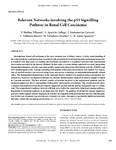Mostrar o rexistro simple do ítem
Relevant networks involving the p53 signalling pathway in renal cell carcinoma
| dc.contributor.author | Medina Villaamil, Vanessa | |
| dc.contributor.author | Aparicio Gallego, Guadalupe | |
| dc.contributor.author | Santamarina, Isabel | |
| dc.contributor.author | Valbuena Ruvira, L. | |
| dc.contributor.author | Valladares-Ayerbes, Manuel | |
| dc.contributor.author | Antón-Aparicio, Luis M. | |
| dc.date.accessioned | 2018-04-10T09:40:35Z | |
| dc.date.available | 2018-04-10T09:40:35Z | |
| dc.date.issued | 2011 | |
| dc.identifier.citation | Medina Villaamil V, Aparicio Gallego G, Santamarina Caínzos I, Valbuena Ruvira L, Valladares-Ayerbes M, Antón Aparicio LM. Relevant networks involving the p53 signalling pathway in renal cell carcinoma. Int J Biomed Sci. 2011; 7(4):273-282 | es_ES |
| dc.identifier.issn | 1550-9702 | |
| dc.identifier.issn | 1555-2810 | |
| dc.identifier.uri | http://hdl.handle.net/2183/20417 | |
| dc.description.abstract | [Abstract] Introduction: Renal cell carcinoma is the most common type of kidney cancer. A better understanding of the critical pathways and interactions associated with alterations in renal function and renal tumour properties is required. Our final goal is to combine the knowledge provided by a regulatory network with experimental observations provided by the dataset. Methods: In this study, a systems biology approach was used, integrating immunohistochemistry protein expression profiles and protein interaction information with the STRING and MeV bioinformatics tools. A group consisting of 80 patients with renal cell carcinoma was studied. The expression of selected markers was assessed using tissue microarray technology on immunohistochemically stained slides. The immunohistochemical data of the molecular factors studied were analysed using a parametric statistical test, Pearson’s correlation coefficient test. Results: Bioinformatics analysis of tumour samples resulted in 2 protein networks. The first network consists of proteins involved in the angiogenesis pathway and the apoptosis suppressor, BCL2, and includes both positive and negative correlations. The second network shows a negative interaction between the p53 tumour suppressor protein and the glucose transporter type 4. Conclusion: The comprehensive pathway network will help us to realise the cooperative behaviours among pathways. Regulation of metabolic pathways is an important role of p53. The pathway involving the tumour suppressor gene p53 could regulate tumour angiogenesis. Further investigation of the proteins that interact with this pathway in this type of tumour may provide new strategies for cancer therapies to specifically inhibit the molecules that play crucial roles in tumour progression. | es_ES |
| dc.language.iso | eng | es_ES |
| dc.publisher | Master Publishing Group | es_ES |
| dc.relation.uri | http://www.ijbs.org/User/ContentFullText.aspx?VolumeNO=7&StartPage=273&Type=pdf | es_ES |
| dc.rights | Atribución 3.0 España | es_ES |
| dc.rights.uri | http://creativecommons.org/licenses/by/3.0/es/ | * |
| dc.subject | Glucose transporter | es_ES |
| dc.subject | Hypoxia | es_ES |
| dc.subject | p53 pathway | es_ES |
| dc.subject | Protein interactions | es_ES |
| dc.subject | Renal cell carcinoma | es_ES |
| dc.subject | Relevant networks | es_ES |
| dc.title | Relevant networks involving the p53 signalling pathway in renal cell carcinoma | es_ES |
| dc.type | info:eu-repo/semantics/article | es_ES |
| dc.rights.access | info:eu-repo/semantics/openAccess | es_ES |
| UDC.journalTitle | International Journal of Biomedical Science | es_ES |
| UDC.volume | 7 | es_ES |
| UDC.issue | 4 | es_ES |
| UDC.startPage | 273 | es_ES |
| UDC.endPage | 282 | es_ES |
Ficheiros no ítem
Este ítem aparece na(s) seguinte(s) colección(s)
-
GI-FENM - Artigos [119]






